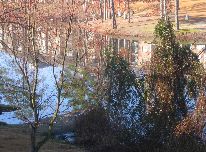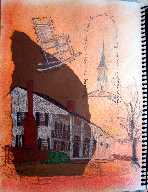 Market House, Fayetteville,
Market House, Fayetteville,
North Carolina. (#0389)

Cool Springs Tavern,
Fayetteville, NC.
(#0324)

Cape Fear River Trail,
Fayetteville, NC. (#0330)

Winter Reflections,
Fayetteville, NC. (#0378)

Sketchbook Impression
of Cool Springs Tavern,
Fayetteville, NC. (#0429)

Sketchbook Impression of
Cape Fear River Trail,
Fayetteville, NC. (#0430)
|
Fayetteville, NC
1528 words
An Historic Southern Community In the Winter
by Dianne Roth
It is difficult to square the concepts of frozen
lakes and heavy southern drawl. They just do not seem to go together.
But, here I am in Fayetteville, North Carolina, dressed in layers
of fleece, wool, and gore-tex, trying to capture the winter scene
in my sketchbook with fingers frozen numb. The lake outside of my
son’s apartment is full of ducks, Canadian geese, and swans,
all walking on the lake’s surface in the early morning chill.
I expect this scene in Oregon. I am surprised in North Carolina.
The weather is not the only thing that surprises me in this southern
city. Yesterday, I was writing with a view of swans bobbing for
tasty tidbits at the bottom of the lake and could hear bombs, mortar
fire, and machine gun bursts. I am staying within two miles of Fort
Bragg where my son is stationed during his medic training. There
are firing ranges and mortar targets throughout the 140,618 acres
of the Bragg military installation. Swans and bombs do not logically
belong in the same scene, but here they are.
Fayetteville was around long before Fort Bragg was built in 1918,
but today it clearly revolves around the military facility along
its northwestern edge. Everywhere I go there are countless military
personnel. So many that in one store I casually walked up to a green-clad
young man I thought was my son and tried to finish a previous conversation.
His southern manners saved me from serious embarrassment.
It was inevitable that my first stop as a tourist was to visit the
Army Special Ops Museum with my son. Located in downtown Fayetteville
and funded by Ross Perot, the museum showcases the history of Army
Special Operations since World War II. It was an unusual place to
find an aging, hippie pacifist, but mothers are often called upon
to follow sons and no one promised it would be easy.
Stores proclaim their pride in the soldiers with big signs and American
flags. Streets are named for generals, wars, battles, and heroes.
There is even an All American Freeway.
But, along side patriotic displays are hints of Fayetteville’s
past. Hay Street, Cotton Valley Drive, Suregrow Court, Poultry Place,
Wheat Way, Potash Place, and Sourgum Way recall its agricultural
roots.
120 miles from the Atlantic Ocean, Fayetteville established an inland
port on the banks of the Cape Fear River. This access to ocean traffic
allowed a hearty commercial trade and made it a center of government
before Raleigh was designated the capitol of North Carolina.
Fayetteville was the hub of six plank roads, the first constructed
in 1849. The longest, to what is now the Winston-Salem area, was
129 miles long. Built on a foundation of logs, three inch planks
were laid and covered with sand. With the inland port and the plank
roads shortening travel time for shipping, Fayetteville’s
economy flourished until railroads crisscrossed the state.
Named after the French Revolutionary War hero, Marquis de Lafayette,
most of the early settlers arrived from Scotland in the 1730’s.
After the Revolutionary War, and without a designated state capitol,
the legislature met in Fayetteville and, in 1789, ratified the U.S.
Constitution and chartered the first American state university,
the University of North Carolina.
Nearly burned to the ground in 1831 and in the path of General Sherman
during the civil war, Fayetteville has rebuilt itself twice. Throughout
four historic areas, there is evidence of meticulous preservation
and restoration. Many sites are not open to the public, but walking
in the footsteps of our history and standing in the footprints of
our ancestors are worth the side trips.
My first walking trip was to see the Cool Spring Tavern. It is the
oldest structure in Fayetteville. Built in 1788, North Carolina
delegates who ratified the U.S. Constitution stayed there, probably
discussing the future of our young nation over the local brew. Still
in the McKethan family, the Cool Spring Tavern is not open to the
public. Even so, I enjoyed imagining the scene in the 1700’s.
Further along Cool Spring Street is the Cross Creek Cemetery. Opened
in 1785, it is full of memories and connections, loves, and losses.
As with all old cemeteries, youth and age stand out. Babies and
children are everywhere, reminding us of the hardships of 200 years
ago. Young men and women in their 20’s died in war and childbirth.
And, old people lived out the full measure of their lives without
them. It must have been exciting to witness the birth of our nation,
but it was not an easy existence.
The tombstones are weathered and moss covered. Many have eroded
beyond recognition. The fallen ones are left where they are, many
with sod growing over their edges. Even the stones, placed to mark
eternity, are slowly being reclaimed by mother nature.
In the center of old downtown Fayetteville is the Market House,
built in 1832 on the site of the original State House. It is a unique,
two story building with a clock tower and a higher tower topped
with a stunning gold weather vane. The second floor was used for
local government business and the first, open-air level, for commerce.
Vendors of meat and produce set up stalls that must have looked
and felt like our own farmers’ markets. Unlike today, there
were stalls in the market that sold human lives. A bronze plaque
in the Market House commemorates their courage and endurance. “Their
suffereing and shame afforded the opportunity for future generations
to be responsible citizens.” (1989)
Another day, a warmer one, I took my sketchbook to the newly opened
Cape Fear River Trail. This four mile, urban trail, meanders alongside
the Cape Fear River. It gently takes you through longleaf pines,
oaks, magnolias, poison ivy, and many other unfamiliar trees and
shrubs. The longleaf was nearly exterminated by shipbuilders who
harvested the trees for their resin and pitch. Workers were called
“tarheels” because the pitch stained the bottoms of
their feet.
The trail crosses several wetlands or swamps using boardwalks and
bridges. One bridge, an exquisitely wrought rusty iron, posed for
both pictures and a sketch. Also, into my sketchbook went some dried
leaves and some sketches of pods that were too three-dimensional
to glue onto the page. The colors, textures, and forms recall cool
breezes, bird songs, rustling leaves, dry winter smells, and the
warm companionship of my daughter-in-law and newest grandbaby.
After several days of discovery I had gathered enough information
to locate the “best” local BBQ. One person indignantly
asked, “North Carolina or South Carolina?” I diplomatically
replied, “North Carolina,” and was given directions.
Twenty minutes after our take-out order was filled, we were enjoying
great North Carolina BBQ with a hint of a not-so-secret family recipe
for spicy sauce.
The cold fled days ago and was replaced by warmth and sun. I walk
with my grandson on most days and am rewarded by the ducks, swans,
geese, turtles, herons, cardinals, and woodpeckers. Trees and shrubs
are showing white, pink, and red buds. I am usually alone on my
walks. It seems that few people spend time outside enjoying the
natural beauty of Fayetteville. That is unfortunate. I suppose it
is because the population is so transient, in and out of Fort Bragg,
not there long enough and too busy to notice.
My sketchbook is filled with my wanderings. But, what is not on
my pages is the litter. The lake is full of it, including a green,
plastic chair. The streets, with stately columns and inviting porches,
are lined with it, everything from whiskey bottles to condoms. There
is so much broken glass the roads glisten.
It must be difficult for the locals to make the effort when so many
people are just temporary citizens. But, I am a temporary citizen
and it would not occur to me to toss... anything out the window.
My upbringing and my back country, leave-no-trace ethic do not allow
it. It is too bad, Fayetteville has a layer of beauty that is easily
missed and hiding it under litter is a tragedy.
As I sit here, the sun has gone down over the lake. A great blue
heron, a pair of cardinals, and three turtles have visited me today.
The door is open to the sounds of the ducks’ quacks and geese
watery landings. I hear the coo of mourning doves, the rustle of
crisp, dry leaves, and the plodding of a C-130 military transport
overhead. Fayetteville is an unusual place.
If you go, be sure to visit the city’s Visitor Center and
the office of the Downtown Business Association. And, track down
the local newspaper office, the Fayetteville Observer. This is one
of the few independently owned newspapers left in the country. Their
front office has a wonderful display of old newspaper equipment
and processes. Tell them Dianne from Oregon met you and says, “Hi”.
They are friendly and eager to help you find that layer of beauty
in Fayetteville.
Dianne Roth is a teacher, mother, grandmother, and freelance
writer. She lives in Oregon.
|
|







